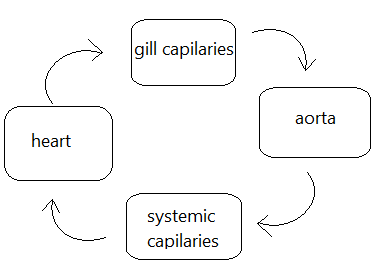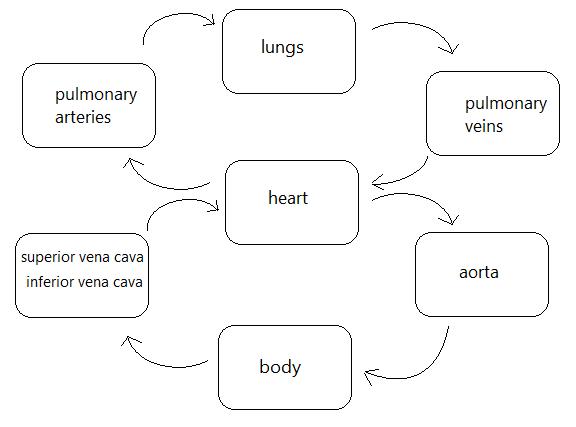
Draw the flow charts for single and double circulation.
Answer
583.2k+ views
Hint: On the basis of the pathway of circulation of blood in one cycle blood circulation is categorized.
Complete answer:
Single circulation:
This circulation is seen in fishes. The blood is pumped by the ventricle of the heart, this blood travels to the gills. In the gills the blood is oxygenated and this travels to the rest of the body to provide oxygenated blood to the tissues. The deoxygenated blood from the system comes to the atrium of the heart.

Double circulation:
This circulating is seen in humans. It starts with the systole of the ventricle. Deoxygenated blood from the right ventricle travels to the lungs for oxygenation via the pulmonary arteries. The oxygenated blood from the lungs travels back to the heart through pulmonary veins and is collected in the left atrium. This is called the pulmonary circulation. With atrial systole the oxygenated blood is passed to the left ventricle. With the next ventricular systole, this oxygenated blood travels through the aorta to the rest of the body. The deoxygenated blood from the body is flushed in the right atrium through the superior and inferior vena cava. This is called systemic circulation. Since there are two circulation cycles this is called double circulation.

Note: Double circulation is the characteristic of mammals and birds. In order to ensure the sufficient supply of oxygen to the cells as they require a great amount of energy to survive. The crocodiles have a similar circulation due to the presence of a four chamber heart.
Complete answer:
Single circulation:
This circulation is seen in fishes. The blood is pumped by the ventricle of the heart, this blood travels to the gills. In the gills the blood is oxygenated and this travels to the rest of the body to provide oxygenated blood to the tissues. The deoxygenated blood from the system comes to the atrium of the heart.

Double circulation:
This circulating is seen in humans. It starts with the systole of the ventricle. Deoxygenated blood from the right ventricle travels to the lungs for oxygenation via the pulmonary arteries. The oxygenated blood from the lungs travels back to the heart through pulmonary veins and is collected in the left atrium. This is called the pulmonary circulation. With atrial systole the oxygenated blood is passed to the left ventricle. With the next ventricular systole, this oxygenated blood travels through the aorta to the rest of the body. The deoxygenated blood from the body is flushed in the right atrium through the superior and inferior vena cava. This is called systemic circulation. Since there are two circulation cycles this is called double circulation.

Note: Double circulation is the characteristic of mammals and birds. In order to ensure the sufficient supply of oxygen to the cells as they require a great amount of energy to survive. The crocodiles have a similar circulation due to the presence of a four chamber heart.
Recently Updated Pages
Master Class 12 Business Studies: Engaging Questions & Answers for Success

Master Class 12 Economics: Engaging Questions & Answers for Success

Master Class 12 English: Engaging Questions & Answers for Success

Master Class 12 Maths: Engaging Questions & Answers for Success

Master Class 12 Social Science: Engaging Questions & Answers for Success

Master Class 12 Chemistry: Engaging Questions & Answers for Success

Trending doubts
What are the major means of transport Explain each class 12 social science CBSE

Which are the Top 10 Largest Countries of the World?

Draw a labelled sketch of the human eye class 12 physics CBSE

How much time does it take to bleed after eating p class 12 biology CBSE

Explain sex determination in humans with line diag class 12 biology CBSE

Differentiate between homogeneous and heterogeneous class 12 chemistry CBSE




